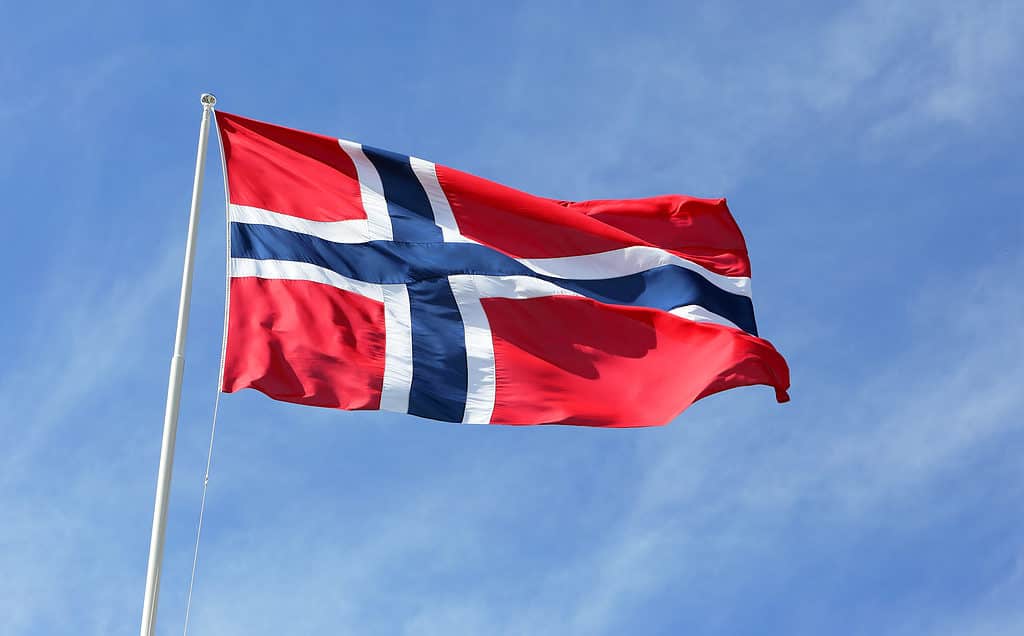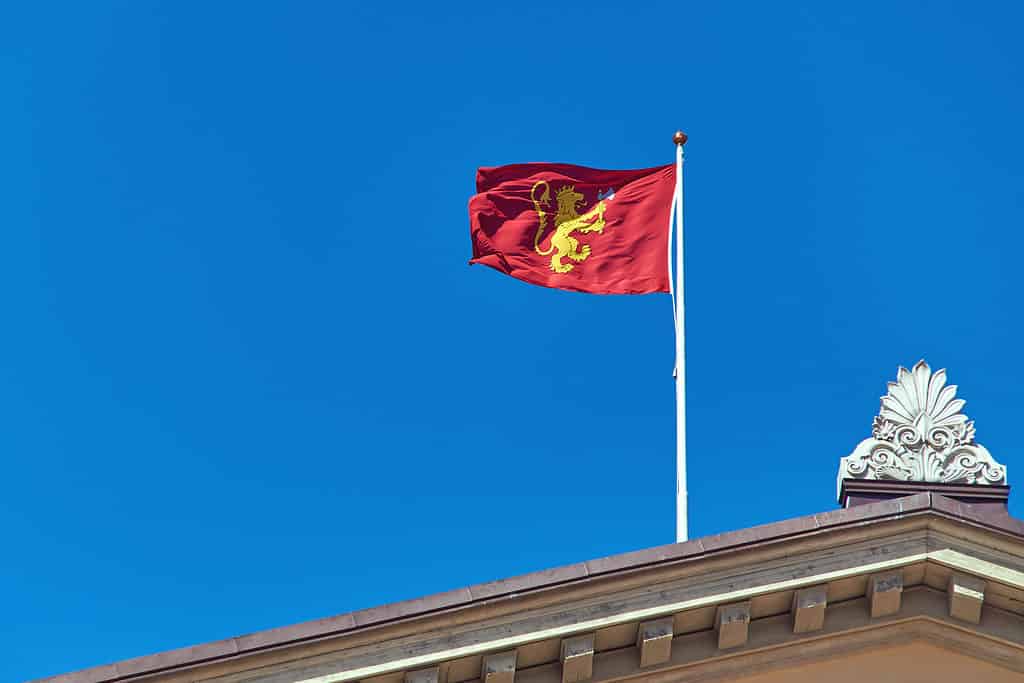All around the world flags have been flown for centuries as a way to represent a place, monarchy, or a political movement. They can also be used to symbolize things such as the past, the future, war, or loss. Flags are visual symbols that can feature a wide variety of shapes, colors, images, and even writing. Crosses are some of the most common symbols used on flags, and the flag of Norway features the Scandinavian cross. Join us as we discover exactly what that is and what it means. We’ll also learn about Norway’s previous flags and a little bit about the history of the country too.
About Norway
Norway is a Nordic country in Europe and its mainland is located on the Scandinavian Peninsular. Norway is a vastly diverse country and has miles of rugged coastline as well as hundreds of islands and fjords. It is also often called the “land of the midnight sun” as between May and July the sun never descends below the horizon in the parts of the country that are north of the Arctic Circle. Daylight can also last for up to 20 hours across the rest of the country.
Norway also has a long and varied history. From 872 to 1397 the area existed as the Kingdom of Norway – also known as the Norwegian Realm. The next period was the Kalmar Union which joined Denmark, Norway, and Sweden between 1397 and 1523. However, Sweden left the Union in 1523 and Norway attempted to follow suit, albeit unsuccessfully.
During the Napoleonic Wars Denmark had been aligned with France and subsequently was forced to concede Norway to Sweden. However, many Norwegians did not like having no choice in the matter and a rise of nationalism led to a brief two-week war with Sweden. Ultimately, their bid for independence was unsuccessful. Despite this short skirmish Norway had a fairly peaceable union with Sweden until it eventually gained independence in 1905.

Norway is a vastly diverse country with miles of rugged coastline as well as hundreds of islands and fjords.
©iStock.com/Smitt
History of the Flag of Norway
The current flag of Norway was adopted in 1821. It consists of a red field with a navy blue Scandinavian cross which is bordered with white. As it is a Scandinavian cross it is off-center and lies more towards the hoist side.
The flag was designed by Frederick Meltzer during the early years of Norway’s union with Sweden. However, the Swedish king refused to sign the law allowing the flag to be used universally across Norway. Instead, he approved it for civilian use only and insisted that both the army and the navy continued to carry the union flag. This consisted of the Swedish flag with a white cross on a red background in the canton to signify Norway.
The new Swedish king decided on a new union mark in 1844. This combined the colors and design of both flags in equal parts to represent the union. From 1844 each country was allowed to display their own flag, but with the new union mark in the canton. However, many Norwegians were still unhappy about this as they wished to be allowed to fly their own flag without any marks in the canton. Therefore, Norway formed a law proposing the removal of the union mark. In 1898 it was approved by the Swedish king – finally allowing Norwegians to fly their own “clean” flag just a few years before Norway and Sweden separated.

The current flag of Norway was adopted in 1821 and has a red field with a navy blue Scandinavian cross which is bordered with white.
©iStock.com/Fotonen
Symbolism and Meaning
The current flag of Norway is based on the flag of Denmark – the Dannebrog – which is red with a white cross. This is to symbolize the former union between the two countries. However, the addition of the blue cross on top of the white one also represents Sweden – which Norway was in a union with at the time of the flag design. Furthermore, the red, white, and blue tricolor is seen as representing freedom and independence.
The use of the Scandinavian cross – also known as a Nordic cross – is a tradition that is used by most independent Nordic countries and the design of the cross represents Christianity. Finland, Iceland, Sweden, Denmark, and Norway all use the Nordic Cross on their flags, leaving Greenland as the only Nordic country without it. Norway was also the first to use the Nordic Cross with three colors.

The red, white and blue colors used in the flag of Norway represent freedom and independence.
©Tatohra/Shutterstock.com
Former Norwegian Flags
Norway has many former flags – which is unsurprising, given its long history. The first flag that was used in Norway was used during its time as the Kingdom of Norway from 872. The design is still in use today as the Royal Standard (the monarch’s flag). It was based on the Norwegian coat of arms and consisted of a red field with a golden crowned lion holding an axe.

The Royal Standard of Norway, still in use today, has a red background with a golden lion holding an axe at its center.
©iStock.com/Berezko
The flag of the Kalmar Union was likely the next flag used in Norway. It was also the first Nordic Cross flag to represent the country. This flag was known as the “banner of the realms” and consisted of a yellow field with a red cross.
We’ve already mentioned that the current Norwegian flag is based on the Dannebrog, and that flag itself flew over Norway following the end of the Kalmar Union. However, at the end of the Danish period and around the same time as the flag of Sweden took its place, a different flag was also flown. During the period that Norwegians attempted to rise up against Sweden a version of the Danish flag was flown. However, it also featured a slightly different version of the golden lion from the Norwegian coat of arms in the canton. This flag remained in use to some extent until 1821 when the current flag was adopted.
Up Next
- White Flag with Red Cross: England Flag History, Meaning, and Symbolism
- The Flag of Denmark: History, Meaning, and Symbolism
- Blue Flag with Yellow Cross: Sweden Flag History, Meaning, and Symbolism
The photo featured at the top of this post is © iStock.com/flowgraph
Thank you for reading! Have some feedback for us? Contact the AZ Animals editorial team.






